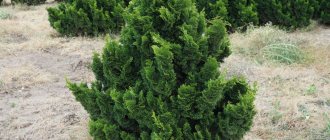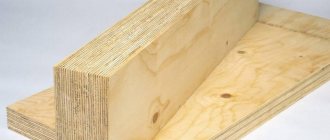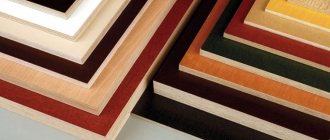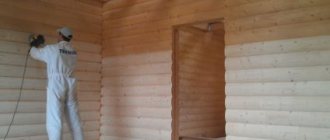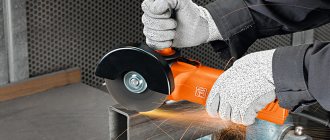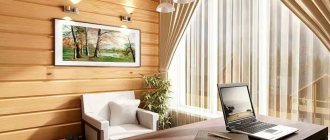Content:
- Features and distinctive features of second grade lumber
- Difference between second grade boards and first grade boards and application
- The difference between second-grade timber and first-class timber and application
- Advantages
- Minuses
- Tips for choosing
Second-grade lumber refers to lumber of good, but not superior quality. They do not have such an impeccable appearance as first-class ones, they are not much inferior to them in terms of hardness and strength, nevertheless they are suitable for the vast majority of construction work in which wood is used, mainly two types of goods are purchased for them.
First grade
The cost of first grade boards and timber is lower; they are most often used in construction.
Basic requirements for the material:
- humidity within 20–22%;
- straight cuts;
- parallel faces;
- fit to size;
- absence of visible signs of fungal damage to wood;
- presence of end cracks within 25%;
- absence of rotten knots.
The slightest deviation from these requirements indicates a violation of the grade of lumber.
Features and distinctive features of second grade lumber
Sorting by grade is carried out by inspecting the material for the presence/absence of various defects. The division occurs in accordance with the requirements of GOST 2695-83 for deciduous wood and GOST 8486-86 for coniferous wood. The following are allowed in second grade lumber:
- Deep cracks on the edges and faces of the product, but their total length should not exceed one sixth of its length;
- Fused and unfused knots no more than 40 mm. in cross section and a total area of not more than one-fourth the width per meter;
- Sapwood staining, mold and fungal marks (spots and streaks). However, their total area should not occupy more than 20% of the total area of lumber;
- Through cracks in the layers. Their length is limited to ten centimeters. If there are more cracks, then the lumber is of lower grade;
- End cracks. They can be present only on one side, and the length of the defects should not exceed one sixth of the length of the product;
- Sloping fibers, heel, pockets, double core;
- Warped. Longitudinal warping should not be more than 0.1% of the total length, and transverse warping should not be more than 0.5%;
- Wormholes, but no more than two per meter.
- The bevel of the cut should not exceed 5%;
- Wood moisture content is no more than 22%.
Rot, foreign inclusions and sharp wane over the entire width of the edge should be completely absent in lumber made from grade 2 wood.
About lumber and standards
For example, laminated veneer lumber is made from waste wood, and it must be taken into account that the hardest part of the trunk is located along the perimeter, and not in the center. For this reason, among many manufacturers, imitation timber of grade A, which is made from waste of a less valuable type, is more valued, while the processing technology has made it possible to achieve a higher level of quality. In fact, this wood is harder and stronger, does not rot even in difficult operating conditions, and it does not have the disadvantages of surface layers.
Pine timber 2nd grade
At the same time, it is worth clarifying that when it comes to grade, it is more correct to talk not only about the grade and type of wood. Professional assessment of wood quality implies a whole set of differences - characteristics described in the profile standard. A number of GOSTs are devoted to the topic of wood, which describe not only the requirements for high-quality lumber, but also the classification of defects.
Taken together, formally the absence of defects and compliance with the requirements for the material allows it to be classified as grade 1 or 2, but in practice it is made of grade 3 or 4. Thanks to sizing, imitations of coniferous species acquire additional tensile strength, therefore they are highly valued as a consumable material.
1st grade
Difference between second grade boards and first grade boards and application
A 2nd grade board has almost the same characteristics as a 1st grade board, but may have wane, resin pockets and bluish spots.
In terms of size, edged boards are usually 25, 40-50 mm thick and 100, 150 mm wide, 3, 4, 6 m long. If the numbers are different, then it is already considered substandard and costs less.
Depending on the characteristics of the 2nd grade edged board, it can be used for rough floors and ceilings. The appearance of the boards in this case does not matter much. Second grade boards are also suitable for roof insulation. The thermal conductivity of wood of the mentioned grade is almost the same as that of first-grade wood. Such boards are also useful for making temporary buildings (sheds, booths, etc.). They may not turn out very attractive, but they will last a long time. For shields and fencing structures, the use of second-grade boards is also justified. Sometimes pallets and containers are made from such boards. For the manufacture of the latter, lower-grade lumber is often used.
In addition to what has been said, 2nd grade boards are often used for interior finishing of bathhouses, attics, gazebos and loggias. Knots, as well as some other defects on the boards in this case, give a certain flavor to the interior of the room.
Types of lumber
When sawing logs longitudinally, lumber with different cross sections is obtained. Figure A shows their options.
Name of lumber according to the type of its cross section
The object of our consideration is a board - one of the popular types of lumber with a thickness of up to 0.1 m and a width more than 2 times the thickness. The sides of the board are parallel to each other. The following types of boards are distinguished:
- Unedged - with wane on both edges (regardless of filing) exceeding permissible standards.
- Single-sided edged - with one sawn edge that has a regulatory permissible wane. The angle between the planes of the layers and this edge is 90°.
- Edged - both edges are sawn with the possible presence of permitted wane.
Important! It is the edged board that is sorted taking into account the requirements for the quality of lumber.
The difference between second-grade timber and first-class timber and application
According to the description of the appearance, 2nd grade timber looks less presentable in comparison with first-class timber; the presence of small fallen knots, pockets of resin, darkening and fungal stains, and deep cracks is allowed.
As for the sizes of second-grade timber, there is a very wide variation in length. GOST 24454-80 sets from 1 to 6.5 m with a gradation of 25 cm. Most often you can find a six-meter one on sale. The thickness of the edged timber can be from 100 to 200 mm in increments of 25 mm. The timber is also sold with a thickness of 250 mm. The width varies from 100 to 250 mm with gradations of 25 mm. In any case, it should be greater than the thickness or equal to it, but not less.
Temporary and auxiliary building structures are often made from second-grade edged timber. It is too expensive to use the highest grades of timber for them, and due to the small differences in characteristics from the 2nd grade timber, it does not make sense. The rough load-bearing subsystems, which are covered with sheathing, are also made from second-grade timber. The fact is that, in addition to the not particularly aesthetic appearance, such timber has somewhat weakened load-bearing capabilities. This disadvantage is mainly due to the defects mentioned above. You can find fences, canopies, and cabins made from the specified material. They serve no less than if they were made from first-class timber, but the cost is much lower.
Varietal characteristics and how to choose the right grade of edged lumber.
In accordance with the standards, edged boards and bars are divided into 5 categories: selected, 1, 2, 3, 4 grades. In terms of humidity, all coniferous assortments except grade 4 must be at least 22, deciduous 20%. In terms of roughness, assortments up to grade 3 must be within the range of 1250 microns, and for grade 4, roughness up to 1600 microns is allowed.
The timber does not have 4 grades, since its main purpose is to withstand loads. If there is even one through knot, the timber is rejected.
Selected variety
Extra-class products are almost never found on the domestic market. A smooth, smooth surface without dry and rotten knots can have healthy edge or edge knots up to 2 pieces per linear meter. Deep end cracks are possible up to 10%, surface cracks up to 16%. Rot, dull wane or deflection of more than 1% is not allowed.
A board made from the heart-shaped part of larch for the floor is called “extra”. No defects are allowed here.
The requirements are the same for all types of wood. Oak and linden boards that meet quality requirements are exported.
The grade is marked on one of the ends in the form of a dash or the index “0” on the face.
First grade
Sometimes the assortments are called grade A. On the surface of healthy knots up to 3 per linear meter, 25% shallow cracks, fungal damage is allowed on 10% of the surface. A small amount of blunt wane is acceptable.
Existing defects do not violate the structural properties of the lumber. Hard wood is used for rafter systems, beams, and interfloor ceilings. Soft varieties are suitable for cladding a room.
Assortment marking is a dot or an inclined vertical strip on the end, one line on the plane.
Second grade
Grade B board has up to 30% shallow cracks, knots, including rotten ones, and resin pockets. There is blue rot and mold on the surface up to 20%. It can be used for laying subfloors or cladding walls and partitions for decorative cladding.
Each board is marked with either two dots or two stripes.
Third grade
Boards pierced through with 16% through and surface cracks reaching half the length and with rotten knots and resin pockets look unpresentable. They can be warped in diameter up to 2%, be tortuous, and have a sharp wane.
The wood has lost its structural properties and is used for formwork, canopies, and the construction of removable scaffolding. They cut boards for boxes from it and knock down pallets.
The material is inexpensive and is marked with three dots on the end or three stripes.
Fourth grade
The board is not marked in any way. Wood with high humidity, sharp wane, and a large number of defects of various types can be used. Since such material does not have the proper load-bearing capacity, grade 4 timber does not exist. The boards are inexpensive and suitable for creating temporary shelters and formwork.
Advantages of second grade lumber
The advantages of second-grade lumber that are important to the buyer include:
- Lower cost compared to products made from premium wood. The price difference can reach 30% or more.
- Good strength characteristics. Due to the presence of defects, they may differ slightly from the characteristics of first-grade wood, but still remain high.
- Long service life with proper care. The defects allowed by GOST almost do not reduce it.
Second grade
The requirements are not so stringent; the material should not contain:
- knots larger than 20 mm;
- rotted and fallen branches;
- cracks more than 1 mm deep, more than 30% of the length;
- areas affected by fungus and rot;
- mechanical damage.
Edged boards and timber of the second grade have satisfactory quality at a low price.
Edged boards and timber grades 3 and 4 are low-quality material, used for the manufacture of containers, packaging, and consumables.
Tips for choosing
When choosing, it is not enough to know about timber and boards of the 2nd grade, what they are, you also need to take into account a number of other factors.
- Understand exactly for which structures you intend to use second-grade lumber products. Check out the acceptable values for them. In particular, strength is extremely important for load-bearing elements, and for those products that are intended to be used for insulation, a minimum number of through cracks and holes from fallen knots, etc.;
- Find out the average price and base your choice on it. Under no circumstances should you buy sawn timber that is too cheap. Surely there is a serious flaw in them that forced the seller to reduce the price;
- Pay attention to the wane. Less is better. You will have to delete it anyway. Otherwise, insects will appear under the bark, which will seriously damage the wood and significantly reduce its service life;
- Try to find out as much as possible about the storage conditions of the batch of material. Further warping of the wood, its moisture content and changes in linear dimensions depend on them.
GOST standards for lumber
In order not to make a mistake when purchasing lumber, you need to familiarize yourself with their characteristics, sizes, and grades.
A number of building regulations will provide you with the necessary knowledge:
- GOST 18288–87 will introduce you to the basic concepts and definitions used in the production of lumber.
- GOST 2140–81 will tell you about visible defects in wood, their classification, methods of determination and measurement methods. The quality of wood affects the strength, durability, and cost of the structure being built. Properly selected lumber allows you to optimize construction estimates and avoid unnecessary costs.
- GOST 24454–80 allows you to accurately calculate the required volume of purchases. This document provides linear dimensions and assortment of materials, permitted deviations from the established parameters.
- GOST 6564–84 will teach you how to correctly measure the main parameters of lumber when purchasing.
- In GOST 8486–86 you will find information about the types of boards and timber, the permissible number and type of defects for each type of wood is given.
You just need to familiarize yourself with the basic provisions of these documents and understand what you need to pay attention to when purchasing. Please note that some suppliers refer not to GOST, but to technical specifications. These products may be manufactured with irregularities, both in quality of material and in size.
According to GOST, all lumber is divided into five grades. When setting the grade, the type of wood, appearance, humidity, and quality of surface treatment are taken into account.
Fourth grade
This is the cheapest grade of edged lumber; a significant number of defects and flaws are acceptable in it. Wormholes up to 6 pcs/m.p. are allowed. and mushroom spots. The product may have a sharp and blunt wane, longitudinal and transverse warping along the edge and along the faces. The fourth grade of edged timber is almost impossible to find on sale due to its weak load-bearing capacity; boards of this quality are still found - but also not often. An article with photographs about defects and vices of wood, terms and descriptions.


